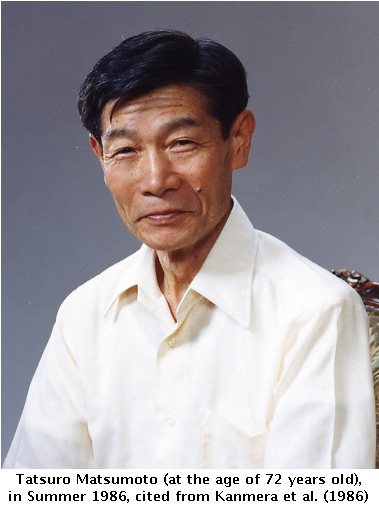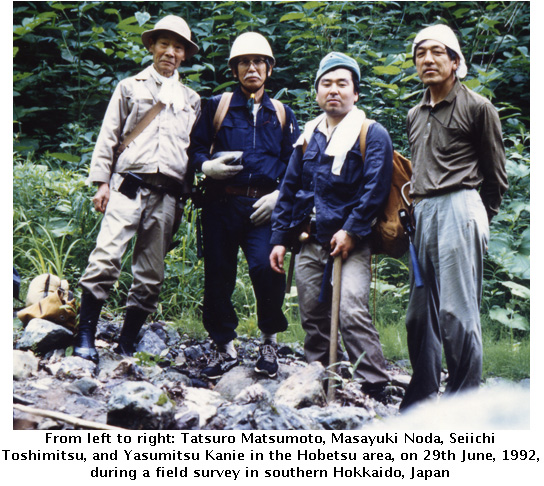Tatsuro Matsumoto
2 November 1913 - 7 February 2009
 Tatsuro Matsumoto, Professor Emeritus of Kyushu University, passed away peacefully at the age of 95 years on 7 February 2009. Prof. Matsumoto was an authority on Cretaceous ammonoids and Mesozoic historical geology, a Member of the Japan Academy, and Honorary President of the Palaeontological Society of Japan. Here, as his students, we express our deep sorrow at his death, and at the same time have the honor of recognizing his contributions to research and education over many years of service.
Tatsuro Matsumoto, Professor Emeritus of Kyushu University, passed away peacefully at the age of 95 years on 7 February 2009. Prof. Matsumoto was an authority on Cretaceous ammonoids and Mesozoic historical geology, a Member of the Japan Academy, and Honorary President of the Palaeontological Society of Japan. Here, as his students, we express our deep sorrow at his death, and at the same time have the honor of recognizing his contributions to research and education over many years of service.
Tatsuro Matsumoto was born in central Tokyo on 2 November 1913. He attended National Shizuoka High School (presently known as Shizuoka University), where he first studied geology under the guidance of Prof. Enzo Konno, who he was to meet again at Kyushu University. For his undergraduate studies, he entered the Department of Geology, Faculty of Science, Imperial University of Tokyo, in 1933. His first paper in geology, entitled "The Katase Formation" dealt with Quaternary rocks of the Sagami Bay coast, about 40 km southwest of Tokyo, was published in the Journal of the Geological Society of Tokyo in 1934, when he was still an undergraduate student. His graduation thesis, entitled "Geology of the Onogawa Basin, Kyushu", published in the same journal in 1936, was the first of many research papers on Cretaceous geology.
During most of his time in the graduate school, Tatsuro Matsumoto's official supervisor, Prof. Teiichi Kobayashi, was in the United States; consequently, he conducted research under the guidance of Prof. Hisakatsu Yabe, who held concurrent professorships at Tohoku Imperial University and the Imperial University of Tokyo. Tatsuro Matsumoto ardently admired Prof. Yabe, as indicated by the framed photograph of Prof. Yabe that was always present on his desk while a professor at Kyushu University.
The Department of Geology at Kyushu Imperial University was established in 1939, and Tatsuro Matsumoto was appointed an associate professor at the university. He published "Fundamentals in the Cretaceous Stratigraphy of Japan, Part 1" in 1942, and "Parts 2 and 3" in 1943 in Memoirs of the Faculty of Science, Kyushu Imperial University, Series D. In 1944, Tatsuro Matsumoto was awarded a D.Sc. as a result of this work and was promoted to professor of palaeontology in the same year. He was appointed professor of stratigraphy in 1955 and remained in this position until his retirement in 1977, having contributed to the development of the department throughout his career.
After retiring from Kyushu University, Prof. Matsumoto took up a position as professor at Seinan Gakuin University, where he continued lecturing until March 1986. In April 1987, he established a laboratory near Kyushu University, which he called Ammons Bunko (Bunko is Japanese for "library"), where he continued studying and encouraging young geologists. In October 2005, Prof. Matsumoto donated the books and other material housed by Ammons Bunko to the Kyushu University Museum, where they can be accessed today.
In 1969, Prof. Matsumoto was awarded the Japan Academy Prize for research on Circum-Pacific Cretaceous ammonoids. He served as Vice-President of the International Palaeontological Association (IPA, 1972-1976), President of the Palaeontological Society of Japan (1973-1977), and President of the Geological Society of Japan (1974-1976), and contributed to the development of these societies. After retiring from Kyushu University, Prof. Matsumoto was decorated with The Order of the Sacred Treasure, Gold and Silver Star in 1986 for his academic achievements, and was inaugurated as a Member of the Japan Academy in 1996.
Although Prof. Matsumoto's research activities were many and varied, his main areas of interest were (1) systematic studies of Cretaceous ammonoids, nautiloids, and inoceramid bivalves, and (2) stratigraphic studies of Circum-Pacific Cretaceous rocks, with special reference to international correlations. His systematic studies on Cretaceous ammonoids covered most taxa, and were published as monographs consisting of between one and five volumes, mainly in Memoirs of the Faculty of Science, Kyushu University, Series D (e.g., Puzosiidae, 1954; Kossmaticeratidae, 1955; Baculitidae, 1963; Collignoniceratidae, 1965-1971; Nostoceratidae, 1967 and 1977; and Acanthoceratidae, 1957-1975). Including these publications, Prof. Matsumoto authored about 100 papers on ammonoid systematics by 2009, including a series subtitled Studies of the Cretaceous ammonites from Hokkaido and Sakhalin.
Prof. Matsumoto also wrote nine papers in English on nautiloid systematics. Among these, "Cretaceous Nautiloids from Hokkaido, Parts 1 to 5" were published in Transactions and Proceedings of the Palaeontological Society of Japan, New Series, in 1983-1984. On the topic of Cretaceous inoceramids, he published "A monograph of the Cretaceous Inoceramus of Japan, Part 1" in 1939 and "Part 2" in 1940, in the Journal of the Faculty of Science, Hokkaido Imperial University, Series IV, co-authored with Prof. Takumi Nagao of Hokkaido Imperial University. Thereafter, he authored or co-authored about 20 papers on inoceramid systematics written in English.
 In terms of Prof. Matsumoto's studies of Cretaceous stratigraphy, his graduation thesis marked the beginning of a long record of published work. The list of publications is too long to mention here, but includes "The Cretaceous System in the Japanese Islands" (1954), "Zonation of the Upper Cretaceous in Japan" (1959), and "Zoning of the Upper Cretaceous in Japan and Adjacent Areas with Special Reference to World-wide Correlation" (1959). The focus of these stratigraphic papers was regionally contemporaneous features of transgression and regression, which were influenced by tectonic movements. Prof. Matsumoto's numerous publications demonstrate his great talent for careful sedimentological observations from the time of his graduation thesis onward. As a summary of these research activities, Prof. Matsumoto led a successful international conference in Japan (Mid-Cretaceous Event--Hokkaido Symposium, 1976--). After retiring, he made significant contributions as a member of the Subcommission on Cretaceous Stratigraphy of ICS/IUGS (e.g., International Symposia on Cretaceous Stage Boundaries in Copenhagen, 1983, and in Brussels, 1995).
In terms of Prof. Matsumoto's studies of Cretaceous stratigraphy, his graduation thesis marked the beginning of a long record of published work. The list of publications is too long to mention here, but includes "The Cretaceous System in the Japanese Islands" (1954), "Zonation of the Upper Cretaceous in Japan" (1959), and "Zoning of the Upper Cretaceous in Japan and Adjacent Areas with Special Reference to World-wide Correlation" (1959). The focus of these stratigraphic papers was regionally contemporaneous features of transgression and regression, which were influenced by tectonic movements. Prof. Matsumoto's numerous publications demonstrate his great talent for careful sedimentological observations from the time of his graduation thesis onward. As a summary of these research activities, Prof. Matsumoto led a successful international conference in Japan (Mid-Cretaceous Event--Hokkaido Symposium, 1976--). After retiring, he made significant contributions as a member of the Subcommission on Cretaceous Stratigraphy of ICS/IUGS (e.g., International Symposia on Cretaceous Stage Boundaries in Copenhagen, 1983, and in Brussels, 1995).
Prof. Tatsuro Matsumoto published a total of 246 papers in English, 159 papers in Japanese, 8 book chapters in English and 14 book chapters in Japanese. He devoted much of his time after retirement to academic research, continuing the work that fascinated him while employed in the Kyushu and the Seinan Gakuin University. He undertook fieldwork in Hokkaido, examining Cretaceous rocks, during every summer for more than 70 years from his twenties to his mid-nineties. During his final moments, he spoke in delirium after he had lost consciousness, saying that "Students are waiting for me, I have to go back to the mountain". For his entire life, Prof. Matsumoto was motivated by research on Cretaceous stratigraphy, up until the moments that preceded his death. We will miss him, yet his life will continue to be an inspiration. May his soul rest in peace.
Hiromichi Hirano, Kazushige Tanabe & Seiichi Toshimitsu
References for the bibliography of Professor Tatsuro Matsumto
- Taneda, S. and Kanmera, K. (1977): Academic records of Professor Tatsuro Matsumoto. Sci. Rept. Dept. Geol., Kyushu Univ.,vol. 12, no. 3, p. 123-138.
- Kanmera, K., Hamamoto, R. and Toshimitsu, S. (comp.) (1986): The academic records of Professor Emeritus Tatsuro Matsumoto of Kyushu University for ten years (1977-1986), in commemoration of receiving the Order of the Sacred Treasure, Gold and Silver Star. c/o Dept. Geol., Fac. Sci., Kyushu Univ., Fukuoka, Japan. 13p.
- Kanmera, K., Okada, H., Sakai, T. and Sano, H. (comp.) (1997): The academic records of Professor Emeritus Tatsuro Matsumoto of Kyushu University for the ten years of 1986-1996, in commemoration of the inauguration as a Member of the Japan Academy. c/o Dept. Earth and Planetary Sci., Fac. Sci., Kyushu Univ., Fukuoka, Japan. 9p.
- Kanmera, K., Okada, H., Hirano, H. Tanabe, K., Sakai, T. and Sano, H. (comp.) (2007): The academic records of Professor Emeritus Tatsuro Matsumoto, Member of the Japan Academy (1997-2006). c/o Dept. Earth and Planetary Sci., Fac. Sci., Kyushu Univ., Fukuoka, Japan. 6p.


 Tatsuro Matsumoto, Professor Emeritus of Kyushu University, passed away peacefully at the age of 95 years on 7 February 2009. Prof. Matsumoto was an authority on Cretaceous ammonoids and Mesozoic historical geology, a Member of the Japan Academy, and Honorary President of the Palaeontological Society of Japan. Here, as his students, we express our deep sorrow at his death, and at the same time have the honor of recognizing his contributions to research and education over many years of service.
Tatsuro Matsumoto, Professor Emeritus of Kyushu University, passed away peacefully at the age of 95 years on 7 February 2009. Prof. Matsumoto was an authority on Cretaceous ammonoids and Mesozoic historical geology, a Member of the Japan Academy, and Honorary President of the Palaeontological Society of Japan. Here, as his students, we express our deep sorrow at his death, and at the same time have the honor of recognizing his contributions to research and education over many years of service. In terms of Prof. Matsumoto's studies of Cretaceous stratigraphy, his graduation thesis marked the beginning of a long record of published work. The list of publications is too long to mention here, but includes "The Cretaceous System in the Japanese Islands" (1954), "Zonation of the Upper Cretaceous in Japan" (1959), and "Zoning of the Upper Cretaceous in Japan and Adjacent Areas with Special Reference to World-wide Correlation" (1959). The focus of these stratigraphic papers was regionally contemporaneous features of transgression and regression, which were influenced by tectonic movements. Prof. Matsumoto's numerous publications demonstrate his great talent for careful sedimentological observations from the time of his graduation thesis onward. As a summary of these research activities, Prof. Matsumoto led a successful international conference in Japan (Mid-Cretaceous Event--Hokkaido Symposium, 1976--). After retiring, he made significant contributions as a member of the Subcommission on Cretaceous Stratigraphy of ICS/IUGS (e.g., International Symposia on Cretaceous Stage Boundaries in Copenhagen, 1983, and in Brussels, 1995).
In terms of Prof. Matsumoto's studies of Cretaceous stratigraphy, his graduation thesis marked the beginning of a long record of published work. The list of publications is too long to mention here, but includes "The Cretaceous System in the Japanese Islands" (1954), "Zonation of the Upper Cretaceous in Japan" (1959), and "Zoning of the Upper Cretaceous in Japan and Adjacent Areas with Special Reference to World-wide Correlation" (1959). The focus of these stratigraphic papers was regionally contemporaneous features of transgression and regression, which were influenced by tectonic movements. Prof. Matsumoto's numerous publications demonstrate his great talent for careful sedimentological observations from the time of his graduation thesis onward. As a summary of these research activities, Prof. Matsumoto led a successful international conference in Japan (Mid-Cretaceous Event--Hokkaido Symposium, 1976--). After retiring, he made significant contributions as a member of the Subcommission on Cretaceous Stratigraphy of ICS/IUGS (e.g., International Symposia on Cretaceous Stage Boundaries in Copenhagen, 1983, and in Brussels, 1995).


